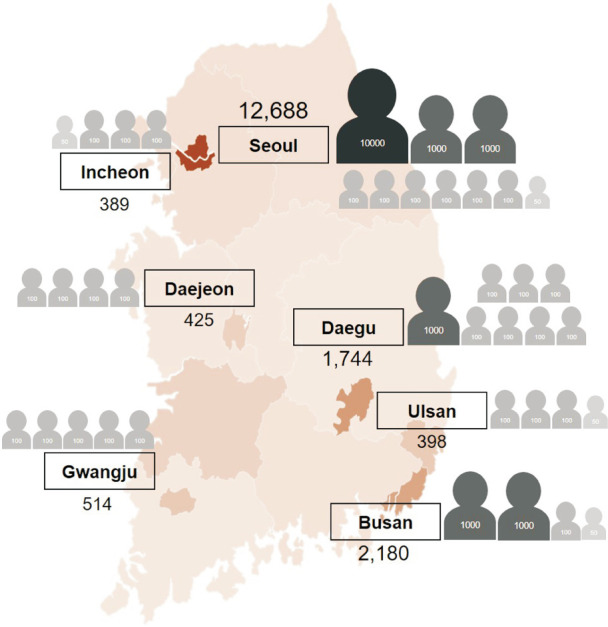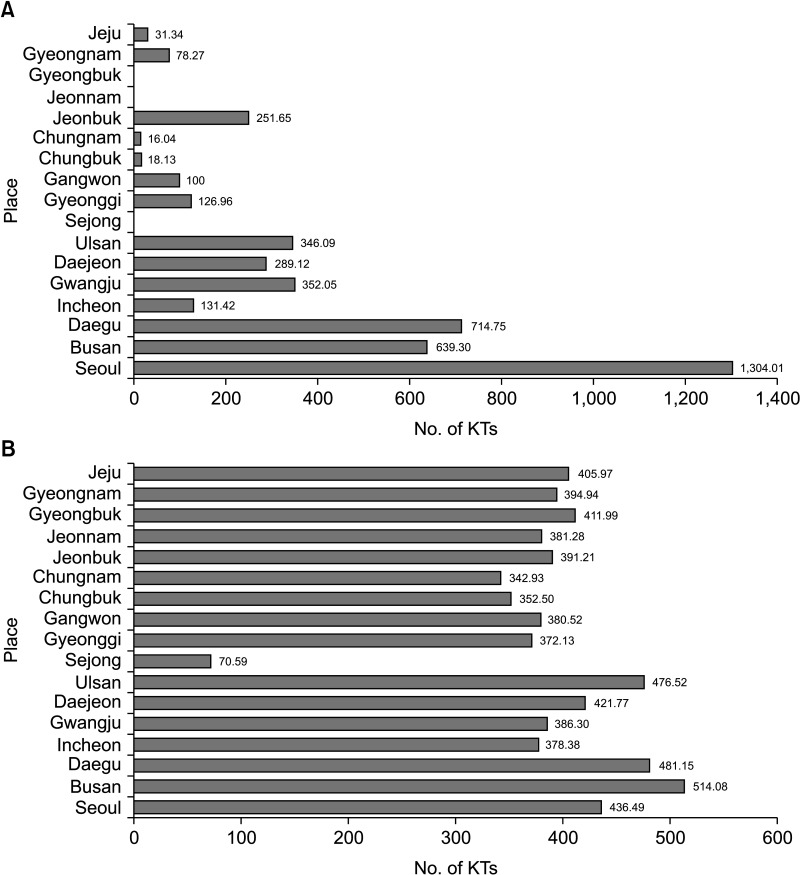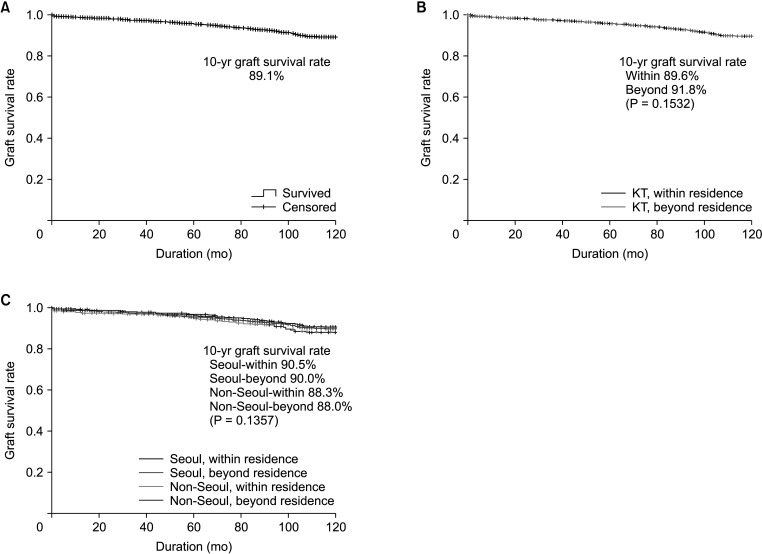Ann Surg Treat Res.
2024 Jan;106(1):11-18. 10.4174/astr.2024.106.1.11.
A nationwide study of regional preference and graft survival of kidney transplantation in South Korea: patterns of centralization in the capital area
- Affiliations
-
- 1Department of Surgery, Ulsan University Hospital, University of Ulsan College of Medicine, Ulsan, Korea
- 2Department of Surgery, Ilsan Paik Hospital, Inje University College of Medicine, Goyang, Korea
- KMID: 2550246
- DOI: http://doi.org/10.4174/astr.2024.106.1.11
Abstract
- Purpose
This study aims to investigate regional patterns and graft survival rates in kidney transplantation (KT) within South Korea using the National Health Insurance Service database.
Methods
By analyzing KT data from 2002 to 2017, including patient residency, KT location, and post-KT dialysis information, graft survival was assessed through post-KT dialysis and validated against Ulsan University Hospital and the Korean Organ Transplantation Registry’s 2017 report.
Results
Among the 20,978 KTs, 60.5% occurred in the Korean capital, Seoul, whereas 39.5% occurred outside. The overall graft survival rate was 81.5% with a median survival duration of 57 months. Patient survival was 83.8%, with a median survival duration of 61 months. For KTs from 2002 to 2007, the 10-year graft and patient survival rates were 89.1% and 90.3%, respectively. The KT recipients living outside Seoul who underwent the KT within their residential regions had a graft survival rate of 88.3%, and those receiving KTs outside their original region had a graft survival rate of 88.0%. Among Seoul residents who underwent KTs in the city, the graft survival rate was 90.5%. Importantly, hospital location did not significantly affect graft survival rates (P = 0.136).
Conclusion
This study revealed a regional preference for KT in South Korea, particularly in the capital city, likely because of nonresidents. Nevertheless, the graft and patient survival rates showed no significant regional disparities. These findings emphasize the necessity for equitable KT service access across regions in order to optimize patient outcomes.
Keyword
Figure
Reference
-
1. Garcia GG, Harden P, Chapman J. World Kidney Day Steering Committee 2012. The global role of kidney transplantation. Lancet. 2012; 379:e36–e38. PMID: 22405254.
Article2. Ahn C, Koo TY, Jeong JC, Kim M, Yang J, Lee J, et al. Initial report of the Korean Organ Transplant Registry: the first report of national kidney transplantation data. Transplant Proc. 2014; 46:425–430. PMID: 24655980.
Article3. Korean Network for Organ Sharing (KONOS). 2019 Annual report on organ transplants and human tissue donation [Internet]. KONOS;2019. cited 2023 Aug 26. Available from: https://www.konos.go.kr/board/boardListPage.do?page=sub4_2_1&boardId=30.4. Song SO, Jung CH, Song YD, Park CY, Kwon HS, Cha BS, et al. Background and data configuration process of a nationwide population-based study using the korean national health insurance system. Diabetes Metab J. 2014; 38:395–403. PMID: 25349827.
Article5. Kwon S. Thirty years of national health insurance in South Korea: lessons for achieving universal health care coverage. Health Policy Plan. 2009; 24:63–71. PMID: 19004861.
Article6. Ock M, Kim JE, Jo MW, Lee HJ, Kim HJ, Lee JY. Perceptions of primary care in Korea: a comparison of patient and physician focus group discussions. BMC Fam Pract. 2014; 15:178. PMID: 25358391.
Article7. Lee JY, Jo MW, Yoo WS, Kim HJ, Eun SJ. Evidence of a broken healthcare delivery system in Korea: unnecessary hospital outpatient utilization among patients with a single chronic disease without complications. J Korean Med Sci. 2014; 29:1590–1596. PMID: 25469056.
Article8. Lim B. Korean medicine coverage in the National Health Insurance in Korea: present situation and critical issues. Integr Med Res. 2013; 2:81–88. PMID: 28664058.
Article9. Park E. Strategies for improving healthcare delivery system in Korea. HIRA Res. 2021; 1:9–15.
Article10. Kim AM, Cho S, Kim HJ, Jung H, Jo MW, Lee JY, et al. Primary care patients' preference for hospitals over clinics in Korea. Int J Environ Res Public Health. 2018; 15:1119. PMID: 29848995.
Article11. Shin JH. Continued increase in patients from regions seeking major general hospitals in Seoul and metropolitan areas [Internet]. Dailymedi;2021. 10. 01. cited 2023 Aug 26. Available from: https://www.dailymedi.com/news/news_view.php?wr_id=874820.12. Wang JH, Skeans MA, Israni AK. Current status of kidney transplant outcomes: dying to survive. Adv Chronic Kidney Dis. 2016; 23:281–286. PMID: 27742381.
Article13. Mudiayi D, Shojai S, Okpechi I, Christie EA, Wen K, Kamaleldin M, et al. Global estimates of capacity for kidney transplantation in world countries and regions. Transplantation. 2022; 106:1113–1122. PMID: 34495014.
Article14. Ojo AO, Morales JM, González-Molina M, Steffick DE, Luan FL, Merion RM, et al. Comparison of the long-term outcomes of kidney transplantation: USA versus Spain. Nephrol Dial Transplant. 2013; 28:213–220. PMID: 22759384.
Article15. Merion RM, Goodrich NP, Johnson RJ, McDonald SP, Russ GR, Gillespie BW, et al. Kidney transplant graft outcomes in 379 257 recipients on 3 continents. Am J Transplant. 2018; 18:1914–1923. PMID: 29573328.
Article16. Chong HJ, Kim HK, Kim SR, Lee S. Waiting for a kidney transplant: the experience of patients with end-stage renal disease in South Korea. J Clin Nurs. 2016; 25:930–939. PMID: 26994991.
Article17. Christiansen T, Vrangbæk K. Hospital centralization and performance in Denmark: ten years on. Health Policy. 2018; 122:321–328. PMID: 29475739.
Article18. Vonlanthen R, Lodge P, Barkun JS, Farges O, Rogiers X, Soreide K, et al. Toward a consensus on centralization in surgery. Ann Surg. 2018; 268:712–724. PMID: 30169394.
Article19. Hong du P, Song J. The effective distribution system for the concentration of patients to extra-large hospitals. J Korean Surg Soc. 2011; 80:373–383. PMID: 22066063.
Article20. Huguet M. Centralization of care in high volume hospitals and inequalities in access to care. Soc Sci Med. 2020; 260:113177. PMID: 32712556.
Article
- Full Text Links
- Actions
-
Cited
- CITED
-
- Close
- Share
- Similar articles
-
- A nationwide study of regional preference and graft survival of kidney transplantation in South Korea: patterns of centralization in capital area
- Characteristics of kidney transplantation recipients over time in South Korea
- A Preliminary Study to Revise the Marginal Donor Criteria of KONOS in Deceased Donor Kidney Transplantation
- Outcome of living donor kidney transplant and deceased donor kidney transplant: a retrospective cohort study at national kidney and transplant institute
- Long term clinical benefits of pancreas-transplantation after kidney transplantation in patients with diabetes who had received kidney transplantation




